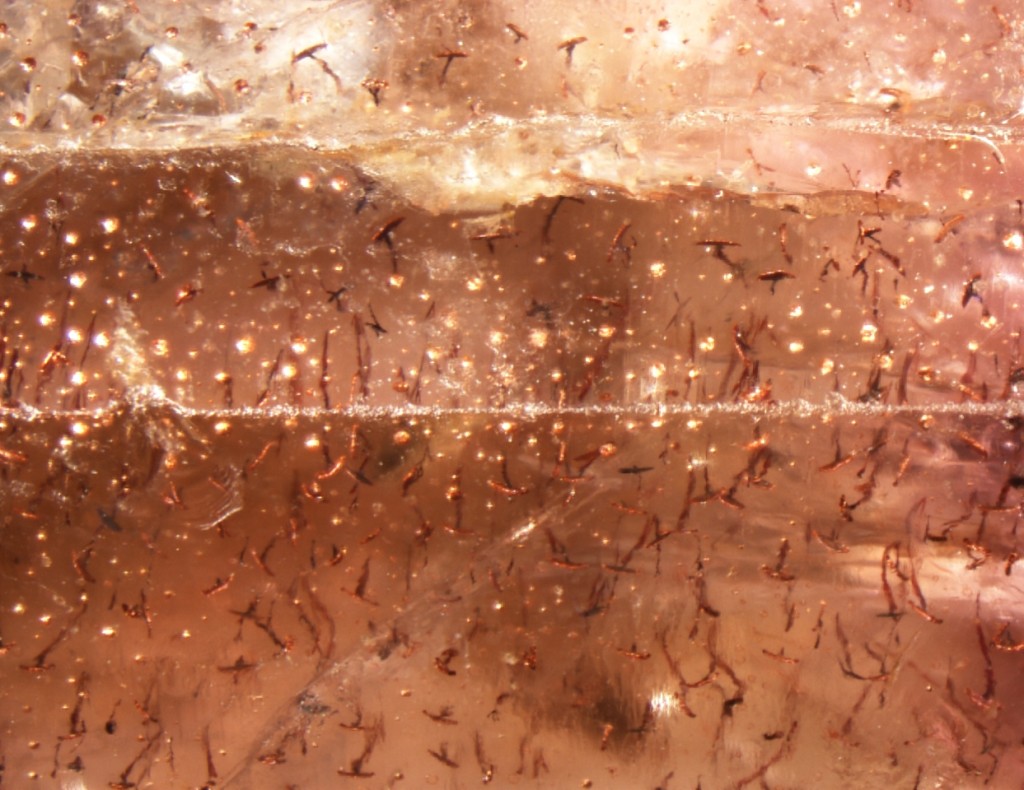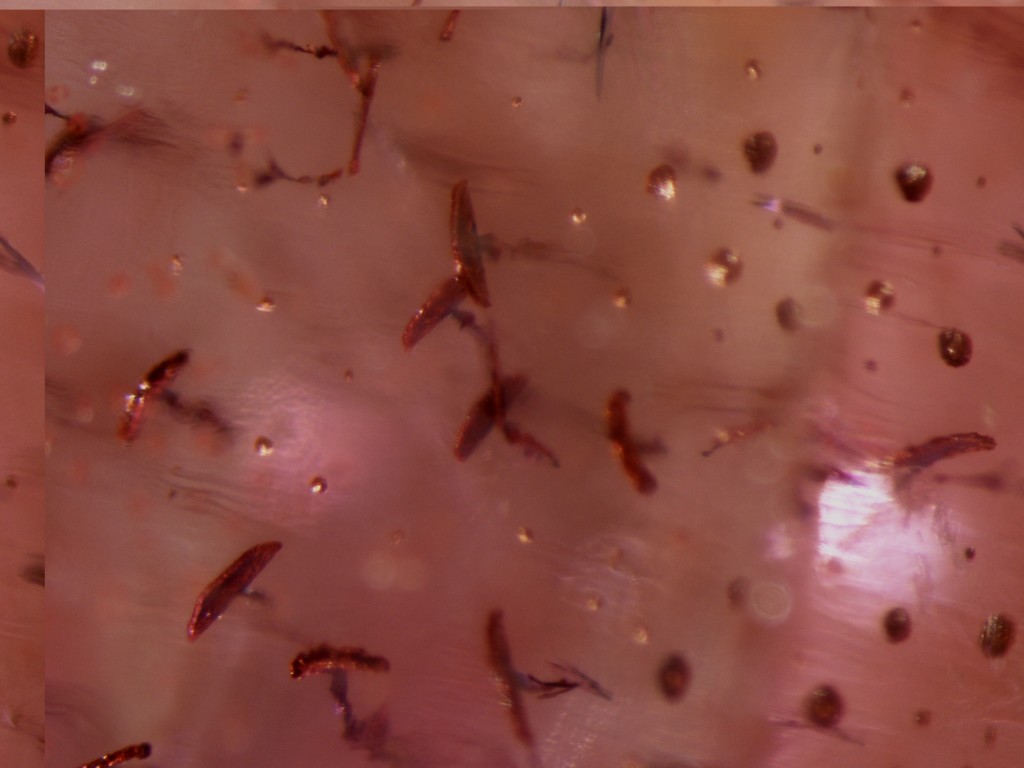28 October 2010
The tale of the hammerheaded copper tadpole
Posted by Callan Bentley
Okay, now just what the heck is going on in these pictures? (All of them can be enlarged by clicking through.)
The photos are different views of the same crystal. It is a broken hexagonal prism of quartz, fading to amethyst at the distal end, found by Doug Dupin of northwest DC during the excavation that led to the Palisades Museum of Prehistory. The crystal is about 3.5 cm long, and 1 cm wide. The curiously-shaped inclusions you see in these photos are ~2 mm long.
Last year, Doug and I photographed the crystal using my new Nikon microscope, and Doug put it up on some mineralogy discussion boards, but got no positive ID. The issue came up again last Saturday night, at a homebrew keg-tapping party at Doug’s museum, where I met Doug’s friend Maria Stenzel, a National Geographic photographer. Maria had also taken a photo of the crystal with her macro lens, and has willingly shared it here*: it’s the last of the three images above. It offers a nice contrast to my images — while hers is sharper and you can see more focused “shape” detail, mine more accurately reflect the colors: the quartz is pinkish purple, more so towards the tip, and the inclusions appear “coppery” in luster and tone.
Key observations: the “hammerhead” shapes are distal to the pointed “tail” of these structures, which are more proximal to the core of the crystal prism. The tails all start at the same depth, and the semi-circular hammerheads all occur at the same “shallower” level in the crystal. Some of the inclusions are “double-headed” that merge into a single “tail.” There are also small spherical coppery balls present, apparently made of the same material but with a different shape.
What is the origin of these inclusions? Why are they shaped in this curious way?
Any insights, well-founded or wildly-speculative, would be welcome. Let us know what you think in the comments section below.
* I think that this may be the first time that a National Geographic photographer has contributed an image to a geology blog. I hereby challenge my geoblogging peers to recruit world-class photographers to take pictures for their blogs too! : )





 Callan Bentley is Associate Professor of Geology at Piedmont Virginia Community College in Charlottesville, Virginia. He is a Fellow of the Geological Society of America. For his work on this blog, the National Association of Geoscience Teachers recognized him with the James Shea Award. He has also won the Outstanding Faculty Award from the State Council on Higher Education in Virginia, and the Biggs Award for Excellence in Geoscience Teaching from the Geoscience Education Division of the Geological Society of America. In previous years, Callan served as a contributing editor at EARTH magazine, President of the Geological Society of Washington and President the Geo2YC division of NAGT.
Callan Bentley is Associate Professor of Geology at Piedmont Virginia Community College in Charlottesville, Virginia. He is a Fellow of the Geological Society of America. For his work on this blog, the National Association of Geoscience Teachers recognized him with the James Shea Award. He has also won the Outstanding Faculty Award from the State Council on Higher Education in Virginia, and the Biggs Award for Excellence in Geoscience Teaching from the Geoscience Education Division of the Geological Society of America. In previous years, Callan served as a contributing editor at EARTH magazine, President of the Geological Society of Washington and President the Geo2YC division of NAGT.
[…] This post was mentioned on Twitter by Callan Bentley, Callan Bentley. Callan Bentley said: My Accretionary Wedge contribution, a short video of office deskcrops http://bit.ly/bTH6Cy […]
[…] The amethyst is one of those mysterious artifacts in the museum collection that should be explainable. There are plenty of American Indian tools on display whose purpose will forever be open to speculation. But the amethyst recovered 10 feet below its current location was created by the predictable forces of chemistry. After prodding the geologist again on the matter, Callan has graciously opened an inquiry on his blog. […]
Callan, I’m wondering if the reddish streaks or “tails” aren’t inclusions of an iron-oxide, possibly hematite like these. I’m not sure about the coppery plates. Copper has been seen in inclusions in plagioclase phenocrysts in Oregon volcanic rocks (sunstones), but I’m not sure what copper would be doing in quartz. Nor can I really explain the particular shapes.
Your first link definitely looks similar to the “tails” in terms of the inclusions’ orientation along a principal crystallographic axis. Thanks.
are the spherical inclusions crystals or fluid?
They appear to be solid, like little copper orbs.
This curiosity appears again. This time, 9 years later provided by sellers in Donghai County, China.
https://www.gemologyonline.com/Forum/phpBB2/viewtopic.php?f=21&t=25002
Was it ever determined what these odd inclusions were?
Are there any more examples in the literature?